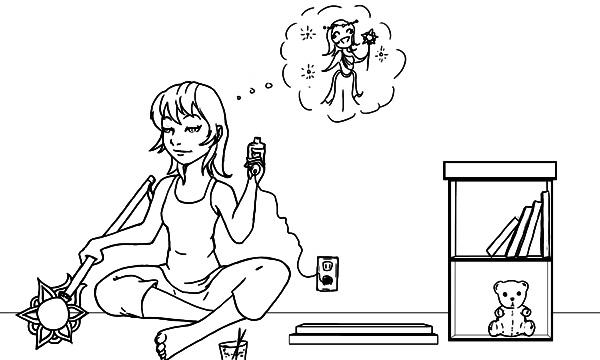Crafting a Costume :: Cosplay Mayhem P3
Let's talk about some basics of costume construction today.
Sewing
Do you fancy yourself good with a needle and thread? Or at least feel confident enough not to end up with too many new holes in your fingers?
Hopefully you have an idea of what exactly needs to be sewn. Depending on if you are making the full costume or just adding details to a thrift store base, you'll want to take different strategies to costume creation.
If you want to make your costume from scratch, well, good luck. I've only made one costume entirely from scratch, and that was my set of Vampire Princess Miyu robes. My mother helped me, but essentially we took a night robe pattern that was the right length and created two robes. The interior robe was her red robe and the exterior the white, though we didn't put any sleeves on the interior one since that would be more cumbersome and they would not have shown. I then sewed a long sash with pointed ends for around my waist. (Reference picture ( http://www.yukishirocosplay.com/miyu.jpg))
This would be the convention where I learned that a sash is not really enough to keep a robe like that closed, no matter how Miyu might fare on TV. Keep that in mind--you might need to make minor alterations to make the costume feasible for an actual human to wear.
The nice thing about simply adding details to an existing piece is that you can do it anywhere. For my first convention, a good part of my Lina Inverse costume was made in the back seat of the car on the way to the con. Of course, we also had only decided a week ago that we wanted to cosplay and one of the members of our group had already gone crazy trying to sew four cloaks in five days.
Finishing an existing piece mostly requires figuring out what needs to be added and then hand or machine sewing it. In fact, glue will work for some details, but it might fall off after repeated use.
Any time you are using fabrics, especially more difficult ones, make sure you know what the washing and ironing needs are. Most fabrics should be washed before you start sewing or before you wear them, but that isn't always true or necessary. Ironing can also be a tricky thing, because it might need low heat. If you don't have a lot of experience sewing, ask someone at the craft store. They are usually full of information and very friendly.

Art byNightambre
Hot glue guns are your friend!
Armor & Weapons
Tricky, tricky--armor and weapons pose a problem for any cosplayers who don't have the money to buy these items. But it is a challenge that many people enjoy.
Now, I'm not really comfortable with a blowtorch or metal working tools, so I tend to make my armor out of more harmless things, like flexi-foam. If there are any local historical reenactment groups in your area, that would be a great place to start if you want to learn how to build real armor.
There are a lot of ways to make armor and the internet is filled with ideas on how to make the needed pieces. In fact, you might even be able to find instructions on how to make the specific character you need. I found a great site with instructions on how to make armor out of many different materials.
Other accessories
Jewelry can be tricky to come by, as often the character wears a very specific piece. Most craft stores have a jewelry section and making a piece might be your best bet, at least for simple necklaces, earrings, or bracelets. Thrift stores can be a good source of jewelry, but it often isn't exactly what you want, and you might need to modify it with paint or glue.
If you have the money to spend, you might be able to purchase a good match at stores such as Claire's and Hot Topic, which tend to carry a lot of different styles and colors.
Other accessories such as gloves, boots, and belts are also best found at thrift stores. Each of these can be made, but they probably aren't something you want to try without knowing something about it first. For odd colored boots, you can make fabric boot covers. Make sure you measure well and I've found it's easier to use a real boot underneath, with a way to tuck the top into the original boot (this way the solidity of the original boot keeps the cover straight and boot-like). A friend made boot covers over a pair of ballet slippers, but they weren't as solid as a real boot base would have been and the fabric over her leg kept trying to slip down, despite using elastic.
There are quite a few websites that sell cosplay accessories like ears, contacts, wigs, and other specialty items. If you are particularly good at making specialty accessories, you might make some extra money by selling your own products.
Hopefully I've given you a base to start on your costume now and some ideas on how you will tackle each aspect. Next time I'll talk more about altering your own appearance: make-up, wigs, contacts, etc.